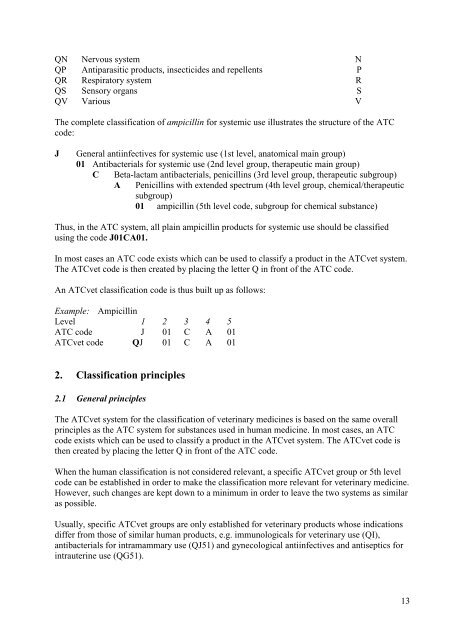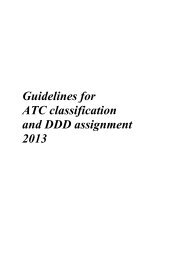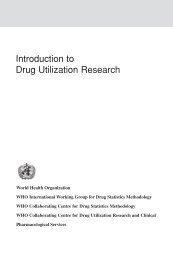Download - WHOCC
Download - WHOCC
Download - WHOCC
Create successful ePaper yourself
Turn your PDF publications into a flip-book with our unique Google optimized e-Paper software.
QN Nervous system N<br />
QP Antiparasitic products, insecticides and repellents P<br />
QR Respiratory system R<br />
QS Sensory organs S<br />
QV Various V<br />
The complete classification of ampicillin for systemic use illustrates the structure of the ATC<br />
code:<br />
J<br />
General antiinfectives for systemic use (1st level, anatomical main group)<br />
01 Antibacterials for systemic use (2nd level group, therapeutic main group)<br />
C Beta-lactam antibacterials, penicillins (3rd level group, therapeutic subgroup)<br />
A Penicillins with extended spectrum (4th level group, chemical/therapeutic<br />
subgroup)<br />
01 ampicillin (5th level code, subgroup for chemical substance)<br />
Thus, in the ATC system, all plain ampicillin products for systemic use should be classified<br />
using the code J01CA01.<br />
In most cases an ATC code exists which can be used to classify a product in the ATCvet system.<br />
The ATCvet code is then created by placing the letter Q in front of the ATC code.<br />
An ATCvet classification code is thus built up as follows:<br />
Example: Ampicillin<br />
Level 1 2 3 4 5<br />
ATC code J 01 C A 01<br />
ATCvet code QJ 01 C A 01<br />
2. Classification principles<br />
2.1 General principles<br />
The ATCvet system for the classification of veterinary medicines is based on the same overall<br />
principles as the ATC system for substances used in human medicine. In most cases, an ATC<br />
code exists which can be used to classify a product in the ATCvet system. The ATCvet code is<br />
then created by placing the letter Q in front of the ATC code.<br />
When the human classification is not considered relevant, a specific ATCvet group or 5th level<br />
code can be established in order to make the classification more relevant for veterinary medicine.<br />
However, such changes are kept down to a minimum in order to leave the two systems as similar<br />
as possible.<br />
Usually, specific ATCvet groups are only established for veterinary products whose indications<br />
differ from those of similar human products, e.g. immunologicals for veterinary use (QI),<br />
antibacterials for intramammary use (QJ51) and gynecological antiinfectives and antiseptics for<br />
intrauterine use (QG51).<br />
13





